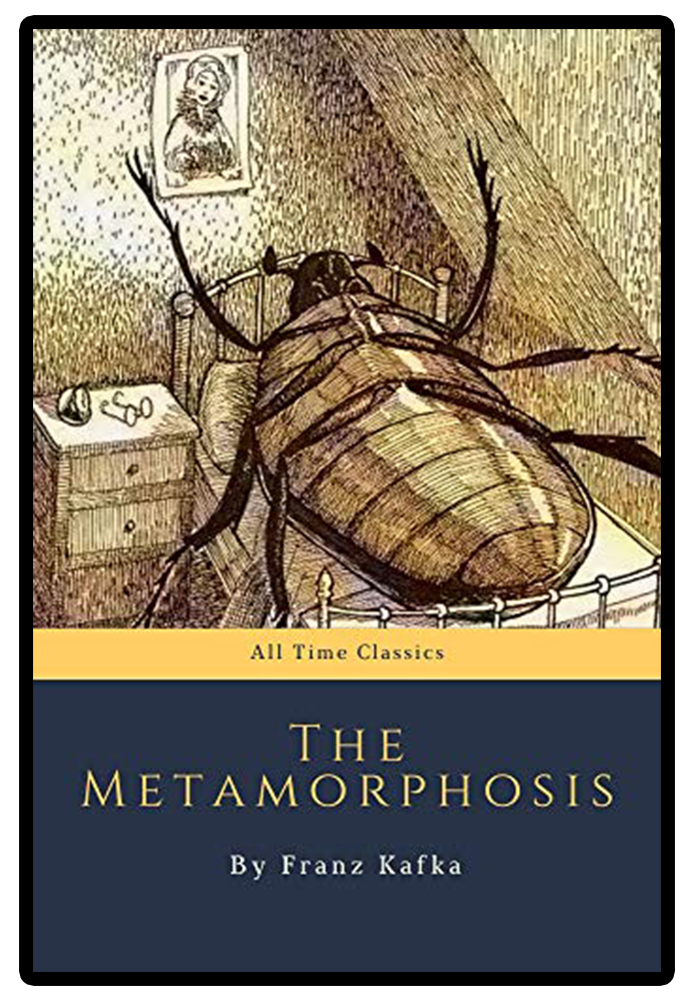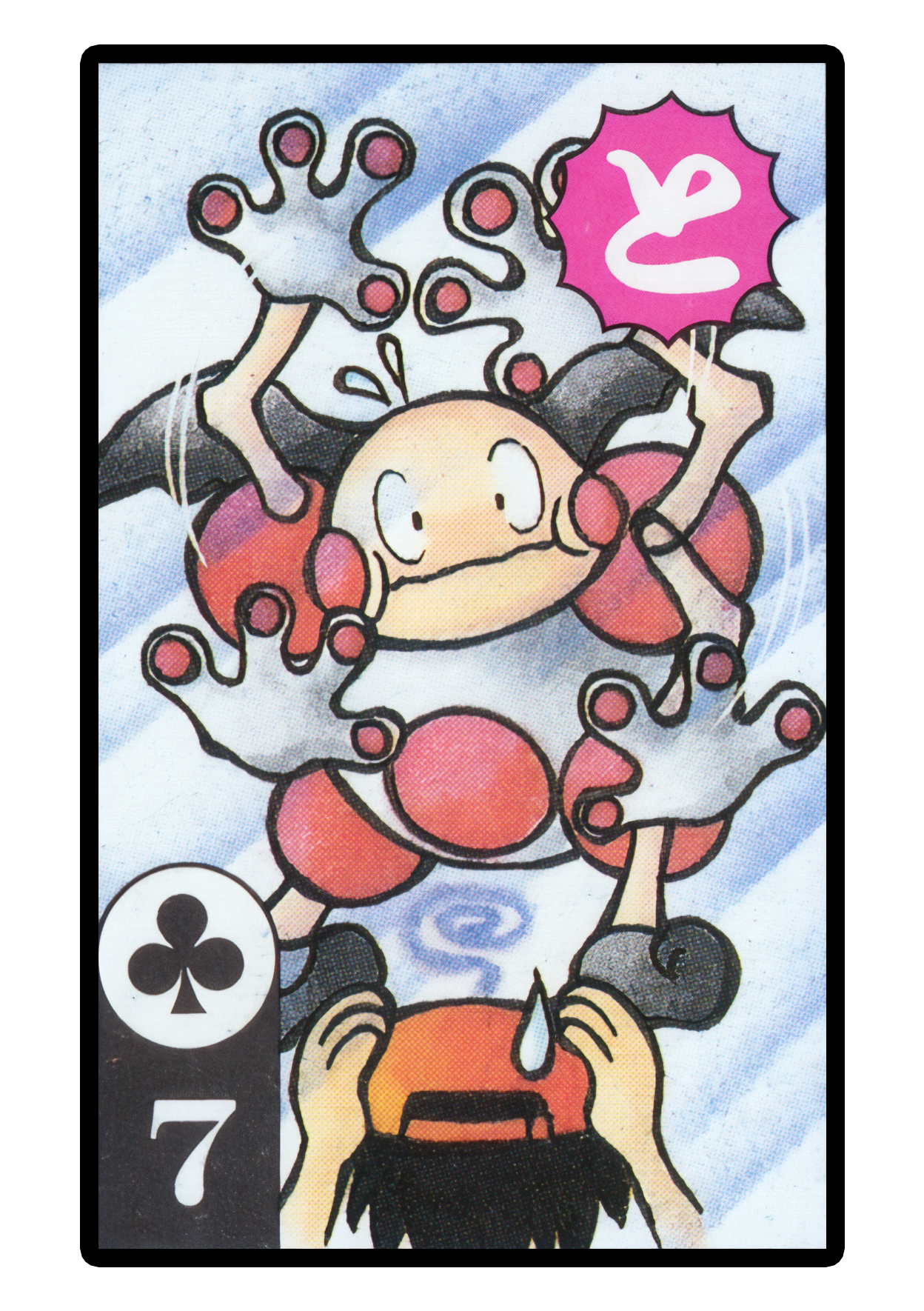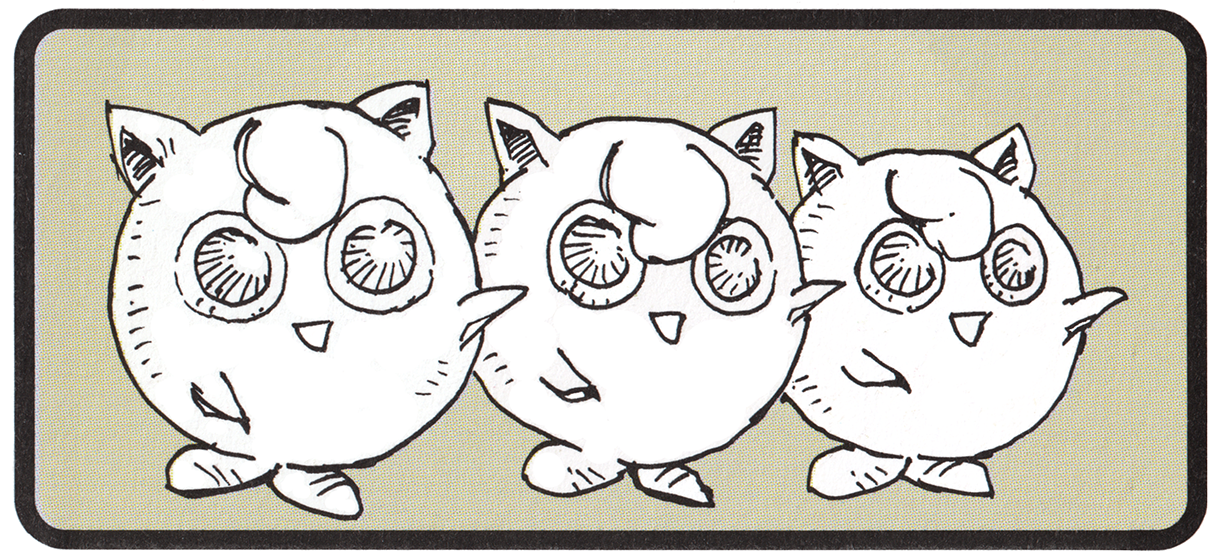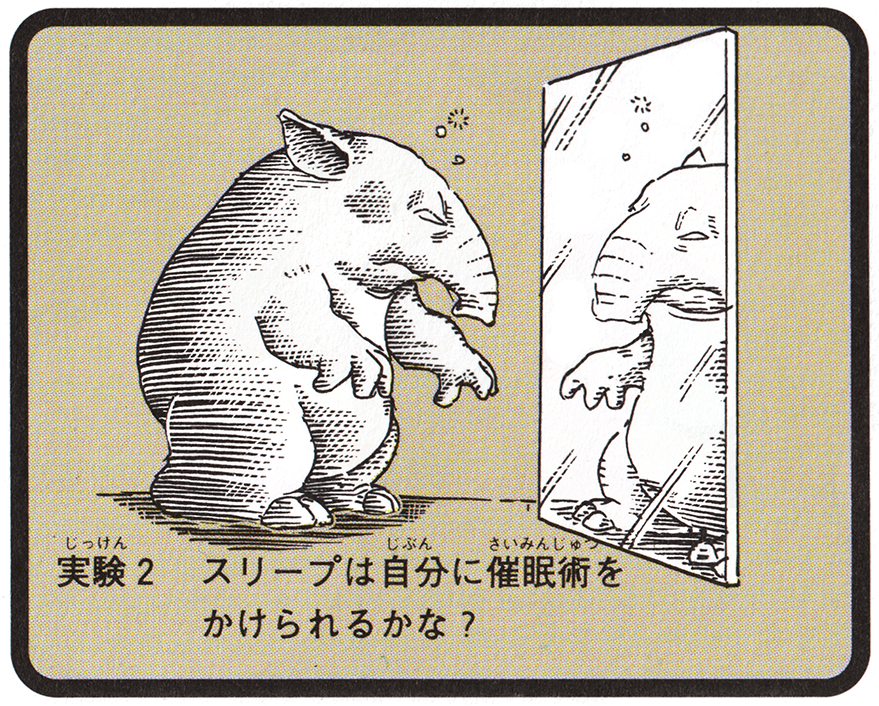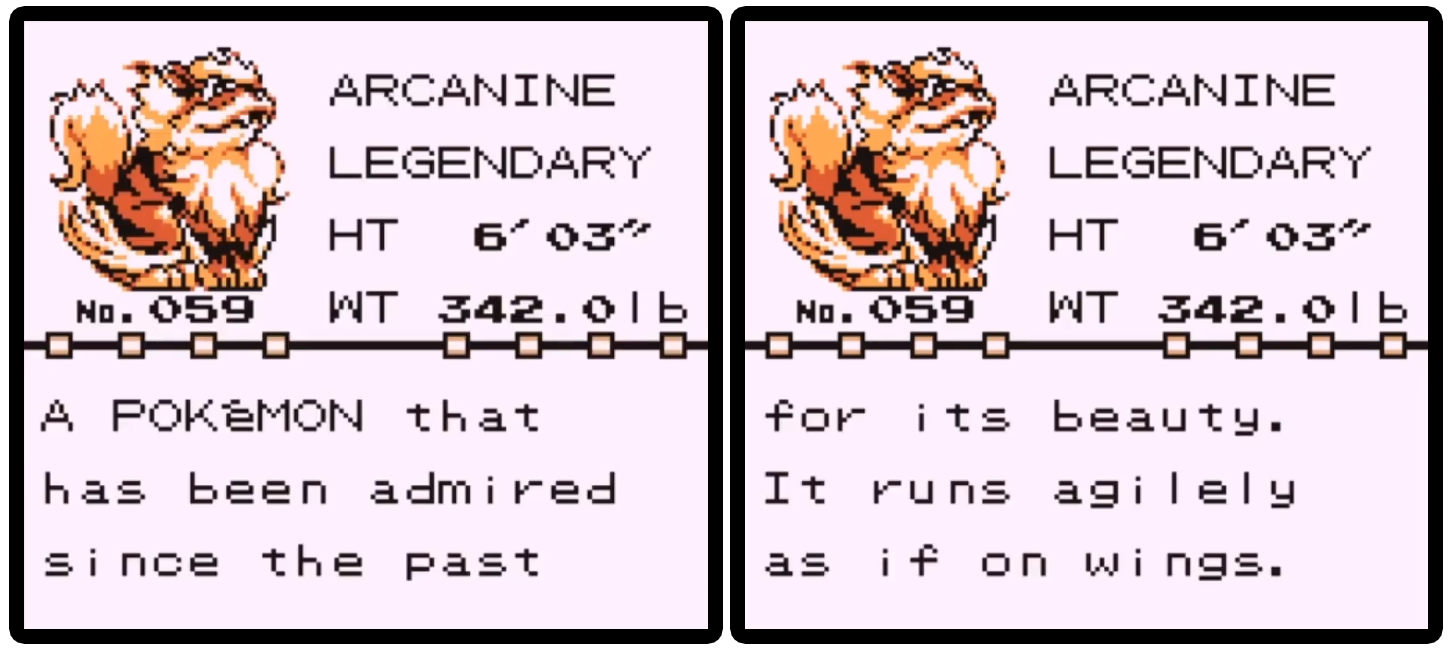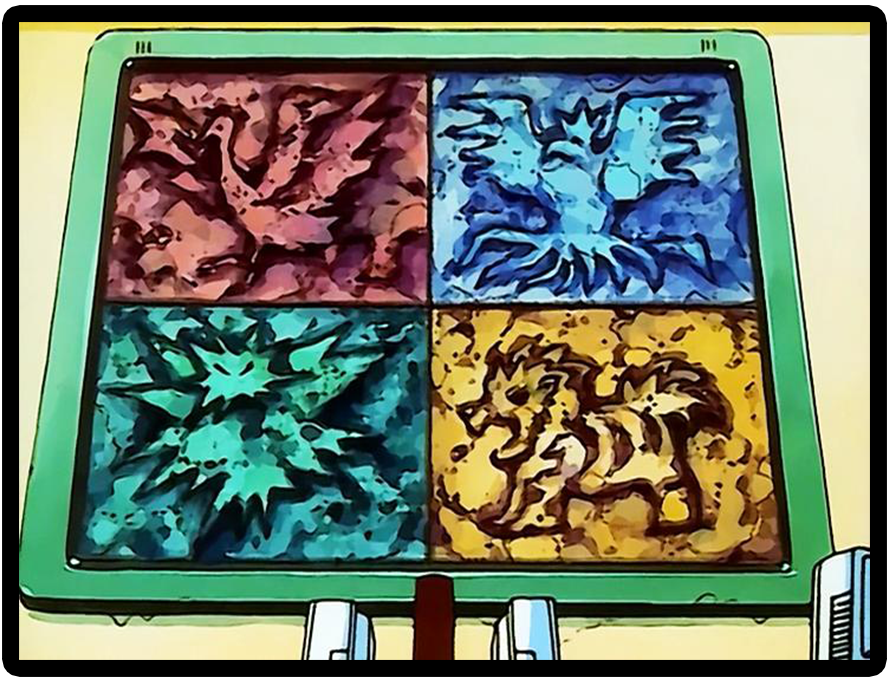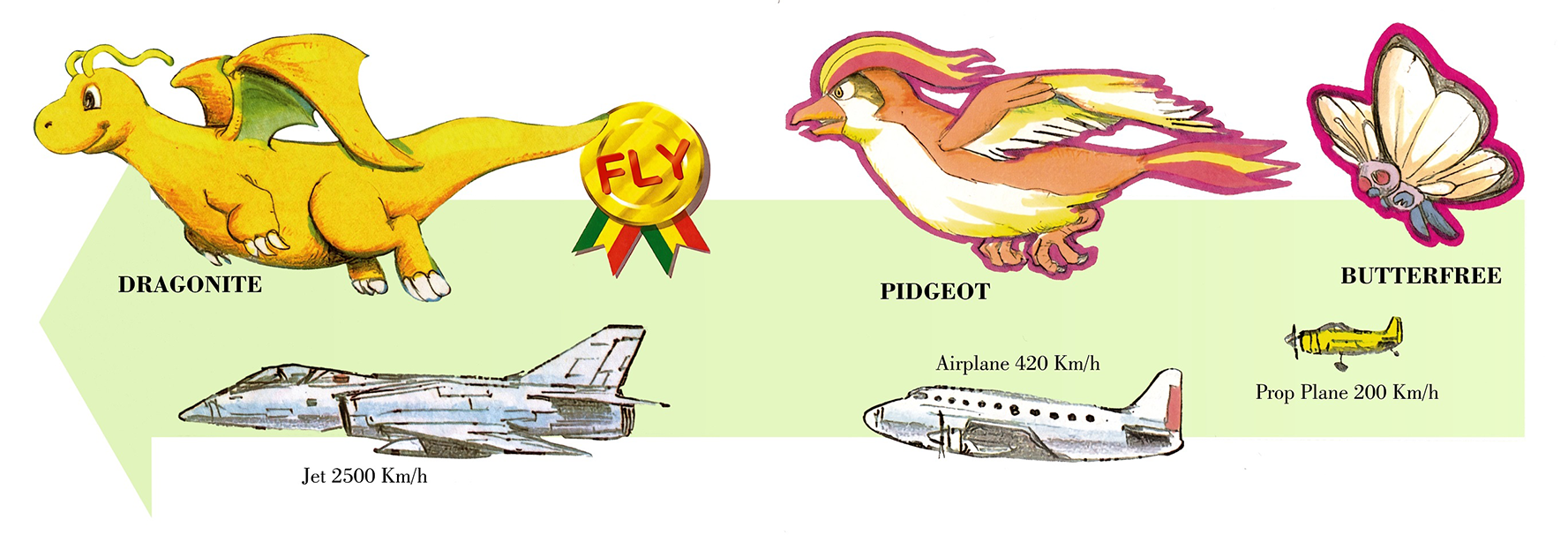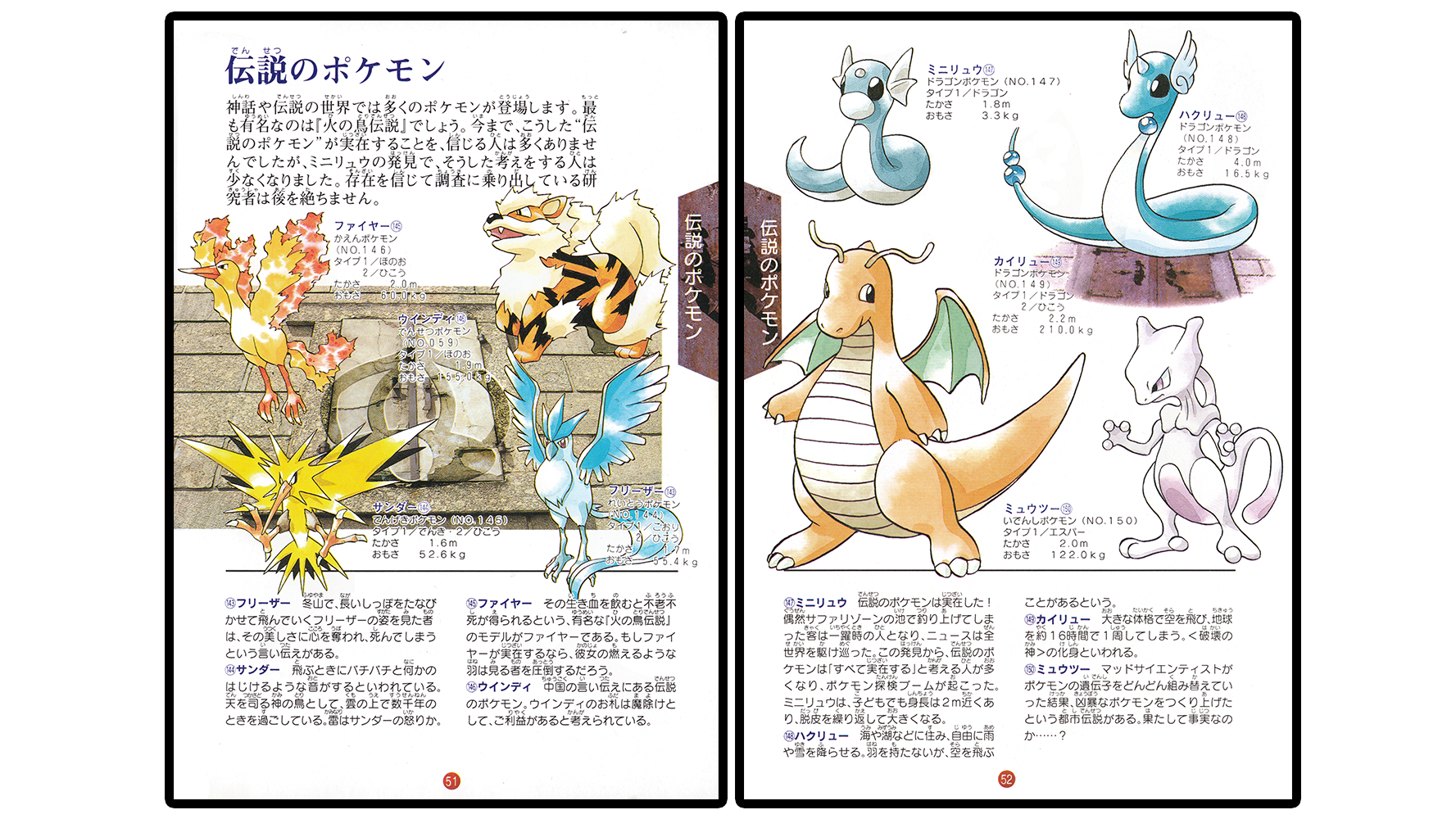
Translation: 1996 Pokédex Book (Part 7)
All 150 Pokédex entries and the introduction
Written by Dr Lava, June 17 2021
This is part 7 of 7 of this translation series. If you’d like to return to a previous part, click one of the links below. Or if you’d rather absorb this 47 page translation in video form rather than reading it through text, click here.
Skip to: Part 1 | 2 | 3 | 4 | 5 | 6 | 7 | Journal | Maps | Itoh Art | Interview | More

“#127 Kadabra: ‘As a psychic boy awoke one morning, he found himself transformed in his bed into a Kadabra.’ The crowning of the Kadabra-themed short story ‘The Transformation’ as the 2nd Pokémon Literary Award winner is still fresh in our memory. If Pikachu is the Pokémon idol, Kadabra can be considered a favorite among those in the know.”
Dr Lava notes: This short story titled The Transformation is an obvious parody on Franz Kafka’s famous 1915 book the The Metamorphosis, a story about a salesman who wakes up one morning realizing he’s turned into an insect. The once sentence excerpted in this Pokedex closely mirrors the book’s very first sentence, which reads: “As Gregor Samsa awoke one morning from uneasy dreams he found himself transformed in his bed into an enormous insect.” This is one instance of the book’s Pokedex contradicting games’ Pokédex — instead of presenting a boy turning into Kadabra as an award-winning short story, Red & Green entry presents it as something that actually happened. It simply says: “As a psychic boy awoke one morning, he found himself transformed in his bed into a Kadabra,” and later Pokedex entries in Emerald, FireRed, and Sun all told varying accounts of the exact same story.
A boy literally transforming into a Kadabra doesn’t really make sense, even in the Pokemon universe, so it seems likely the story was meant as fiction from the very beginning, and possibly shortened to fit into the in-game Pokedex’s single screen. But this is just my interpretation, as there are various ways you could rationalize the contradiction. Whether or not it’s meant to have actually occured, Corocoro’s Eight of Clubs provides artwork for what it would’ve looked like.
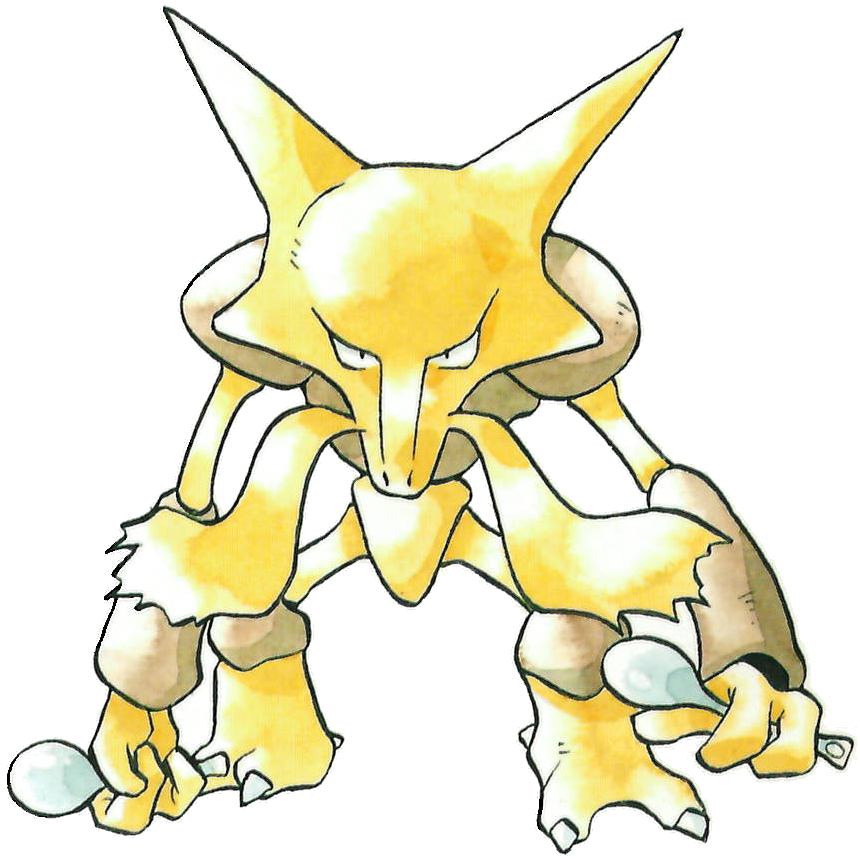
“#128 Alakazam: Disdainful of physical attacks, they adeptly wield extrasensory powers to defeat their foes. While they are believed to be Kadabra’s evolution, no one has proven it conclusively. In battle, Alakazam remain expressionless throughout.”

“#129 Clefairy: Popular as pets for their adorable appearance. They are surprisingly well liked by not only people but even by their fellow Pokémon. However, they are also few. They have only been captured in the caves of Mt. Moon. Clefairy is best at using the move Metronome which triggers a random move from many choices. Occasionally, they startle themselves by loosing a powerful move that doesn’t suit their cute appearance.”

“#130 Clefable: Neither Clefairy nor Clefable like squabbling. Perhaps that explains why their hearing is so superbly developed. They can even discern the sound of a pin dropping 1 kilometer away. They immediately flee if they hear danger approaching.”

“#131 Ditto: They transform into other life forms by rearranging their body’s cellular structure. They learn almost no moves of their own. Ditto can be considered one of the most enigmatic Pokémon ever.”

“#132 Mr. Mime: They use advanced moves like Confusion, Light Screen, Meditate, and Substitute. Being skilled mimes, they are masters at convincingly tricking people. It is said the walls they mime turn real. Their fingertips end in suction pads with which they apparently climb the walls they create. Little headway has been made in their study owing to the scarcity of specimens.”
Dr Lava notes: Corocoro’s Seven of Clubs gives us a good look at Mr Mime climbing one of its invisible walls. During Gen 1’s English localization, Nob actually fought against naming this Pokemon Mr Mime — he wanted to go with a gender neutral name, like how in Japanese it’s called Barrierd. He told his boss at Nintendo of America that naming it Mr Mime would come back to bite them if Game Freak introduced genders in the sequel. He was laughed off at the time, but ultimately he was proven correct when Gen 2 ended up containing lots of female Mr Mime.

“#133 Jigglypuff: With their round and huge eyes they draw the attention of their foes. They then sing a comfortably soothing tune that lulls their foes to sleep. Belying their adorable appearance, they can learn a diverse array of moves. If they become displeased, they inflate themselves like a balloon.”
Dr Lava notes: Here the book provides some Itoh artwork for a chorus of Jigglypuffs, which apparently induces triple the drowsiness compared to the song of only one Jigglypuff.

“#134 Wigglytuff: The finely dense and supple fur is dreamily gorgeous. It is also a luxury item. While they share many moves with Jigglypuff, they additionally learn Hyper Beam.”
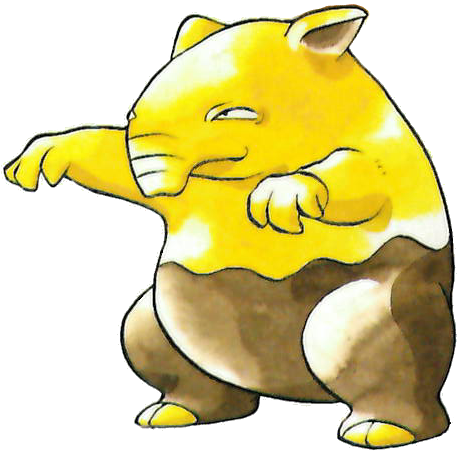
“#135 Drowzee: The descendant of the legendary creature, Baku, which is said to have eaten dreams. Drowzee is famous as the first Pokémon to use a move combo – Hypnosis followed by Dream Eater. They are gluttonous herbivores. From their four stomachs, they repeatedly bring up eaten food and rechew it to feed. They are not popular among women due to their appearance. They also have a habit of muttering under their breath to themselves.”
Dr Lava notes: The Baku is a creature from Japanese mythology who devours nightmares. Traditionally the Baku’s believed to have been created using leftover piecest the gods didn’t use when they created all the other animals. But in modern times it’s usually depicted as a tapir, a Southeast Asian mammal that looks like an elephant mixed with a pig.
Drowzee being a descendant of the Baku means that canonically, in addition to real-life animals, Pokemon also share our world with mythical creatures and can even evolve from them. The book shows us another experiment conducted by the Pokedex researchers, seeing if Drowzee’s capable of hypnotizing itself, and Corocoro’s Jack of Diamonds shows us Drowzee eating a kid’s dreams.
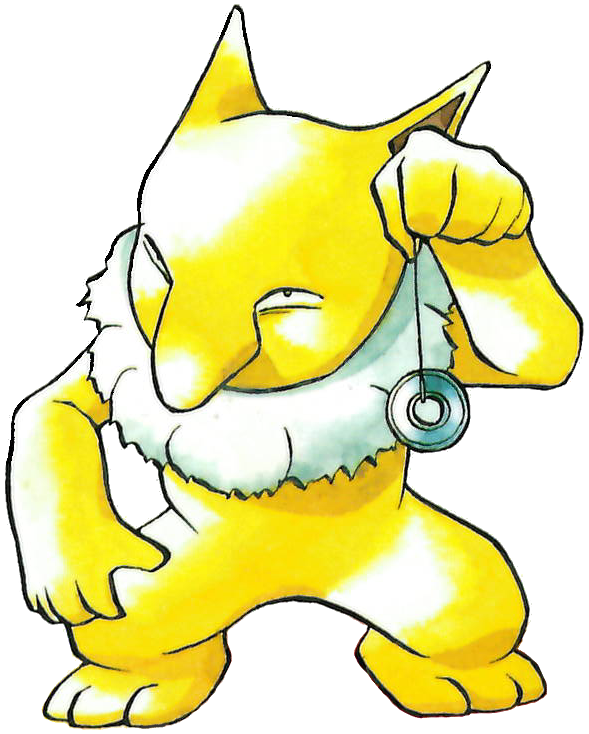
“#136 Hypno: Drowzee’s evolution. They carry around a pendulumlike object. They are skilled at using Psychic. In towns where Hypno appear, child disappearances mysteriously surge.”

“#137 Jynx: An extremely rare Pokémon. They become volcanically enraged if any attempt is made to remove the clothlike shroud around their waist. That reaction informs us they have a sense of shame. While they speak in a humanlike manner, their language is indecipherable. Linguistic research is ongoing.”
Dr Lava notes: Jynx’s Corocoro card gives us a glimpse of her humanlike but indecipherable speech. As for Jynx feeling shame when the researchers tried to strip off her clothes… well, I’m just gonna skip over that bit and continue onto the next section.
Extinct Pokemon
“Pokémon are said to have appeared around two million years ago. Since then, they adapted to the world’s changing environments and evolved in many ways. What did these ancient Pokémon look like? Using recently discovered fossils, their likenesses have been reconstructed.”

“#138 Aerodactyl: The progenitor of birds. They stood 1.8 meters tall. They flew on broad wings while emitting high-pitched cries. From the skull’s structure, it is evident their brain was relatively large. Some biologists claim they communicated by crying. Judging by their stiff fangs they were undoubtedly carnivorous. They must have caught small creatures with their large claws and preyed on them. A very recent discovery of their fossilized droppings attests to this theory.”
Dr Lava notes: The entire concept of Extinct Pokemon appears to have been lifted from the 1993 film Jurassic Park, which landed in theaters halfway into Red & Green’s six year development. In the movie, scientists resurrect dinosaurs by extracting DNA from prehistoric mosquitoes preserved in amber. The key item used to resurrect Aerodactyl is called “Old Amber,” and its official artwork shows a mosquito trapped inside. In countless interviews Tajiri and Sugimori have said Pokemon was partly inspired by Japanese TV shows and monster movies like Ultraman and Godzilla, and even though they never confirmed it, it’s probably safe to assume they drew inspiration from one American monster movie as well.
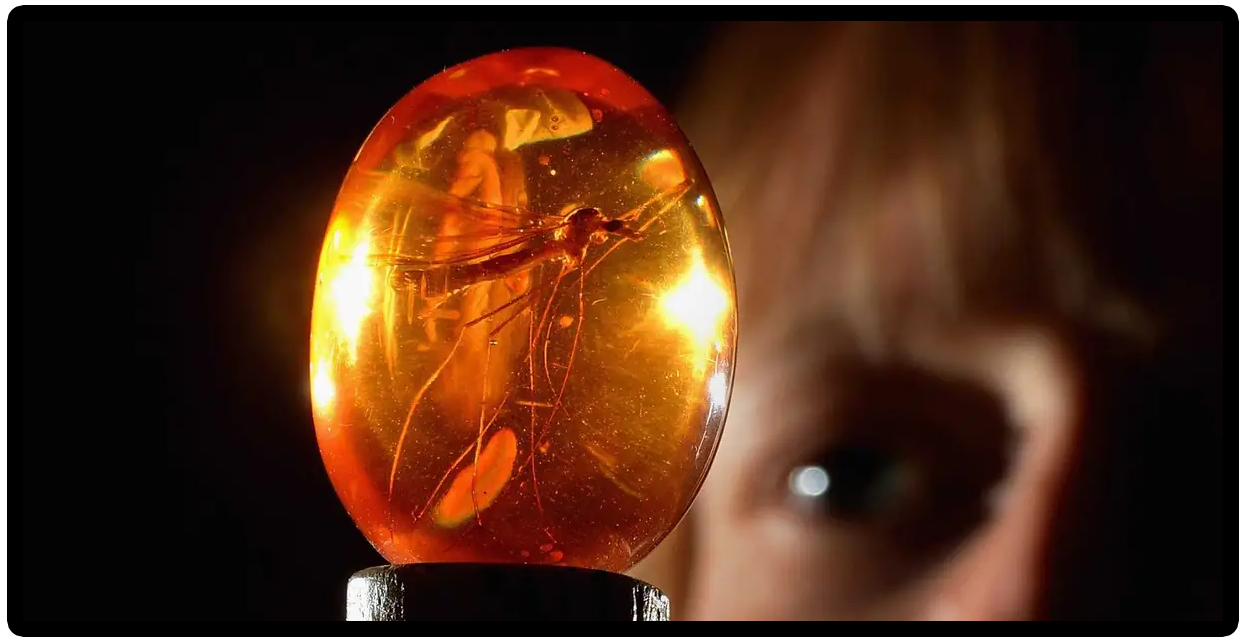
Before moving on to the rest of the Extinct Pokemon, it’s worth pointing out an apparent contradiction with future canon. This entry says Aerodactyl is the progenitor of birds, and when Archen was introduced in Generation 5, its in-game entry identified it as the ancestor of all bird Pokemon. In other words, they’re both said to have been the very first. To put these dueling entries into a modern perspective, let’s hearken back to an interview conducted in 2018, when Game Informer asked if Pokemon evolve and are subject to natural selection — to which Sword & Shield’s director and producer both said they didn’t know. But the concept of Darwinian evolution has existed in the series forever — from this book in 1996, to Archen’s Gen 5 entry, and even Skorupi’s entry in Sword & Shield. The next thing the developers said is the rules of the Pokemon world aren’t “set in stone,” which suggests Game Freak simply aren’t interested in maintaining a consistent canon. As I said earlier, this book is official, published by Creatures Inc with contributions from Satoshi Tajiri himself — which is more than can be said for even some of the mainline games. So even if modern developers or Pokedex entries present contradictions, this book represents the original canon… even if the series as a whole doesn’t take the concept of canon as seriously as some fans might want it to.

“#139 Omanyte: A creature somewhere between sea snails and squids that lived in ancient seas. They swam by waving their ten feet. They fed on plankton and small fish.”

“#140 Omastar: Thought to be Omanyte’s evolution. They grew to around 1 meter height. They preyed on fish up to around 50 centimeters. They hunted by grabbing and clinging to prey with their dexterously developed tentacles and biting at the same time.”

“#141 Kabuto: Said to be the ancestor of both hermit crabs and of turtles. They kept themselves sheltered in their tough shell. They appear to have disliked fighting. They are thought to have been good swimmers, although not especially fast. Just recently, a Kabuto fossil was found in a mountain cave 1,000 meters above sea level. Its discovery revealed that the area had once been submerged under the sea.”
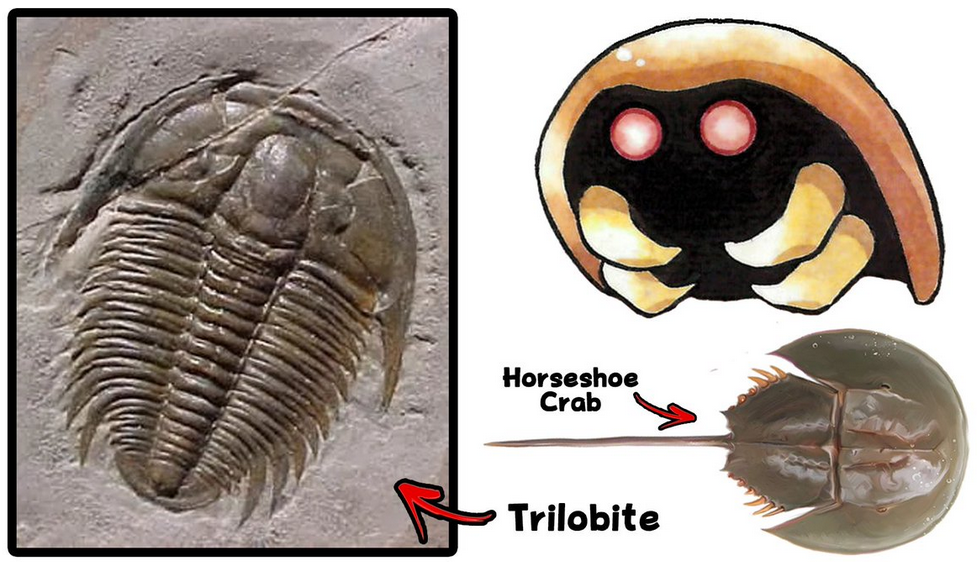
Dr Lava notes: This Pokedex identifies several Pokemon who evolved from animals over the past two million years, but this entry identifying Kabuto as the ancestor of hermit crabs and turtles means it’s a two-way street, and canonically, some real-life animals actually evolved from Pokemon.

“#142 Kabutops: Thought to be Kabuto’s evolution. They swam expertly underwater where they hunted. They captured prey with their sharp scythe arms and drained the prey of their body fluids. Evolution apparently flipped their nature from timid to aggressive. The relationship between Kabuto and Kabutops can be likened to that of mogwai and gremlins. The one and only Kabutops’ fossil was discovered six years ago in a soil horizon approximately two million years old. They are therefore considered the oldest of all Pokémon.”
Dr Lava notes: Satoshi Tajiri confirmed in a 2000 interview that the movie Red’s mom is watching on TV is the 1986 film Stand By Me, so I guess it shouldn’t come as a surprise that the 1984 comedy horror Gremlins exists in the Pokemon universe as well, along with seemingly everything else in the real world. Mogwai are a special classification of demons in Chinese mythology, but in the movie they’re nice furry creatures who transform into evil Gremins that torture and kill humans. In other words, Kabuto’s a nice little guy while Kabutops is the complete opposite. The book provides this illustration of Kabutops using its scythes to impale a large prehistoric sea creature and suck out its fluids, presumably about two million years ago. Four years later, this scene was recreated in anime episode 163, Fossil Fools.

Legendary Pokemon
“Many Pokémon appear in the worlds of myths and legends. The most famous must be ‘The Phoenix.’ Previously, there had been few believing in the existence of such Legendary Pokémon. Since the discovery of Dratini, however, the non-believers are dwindling. Now, an endless stream of researchers embarks on expeditions convinced that the legends live.”

“#143 Articuno: They fly among wintry mountains with their long, flowing tails streaming in their wake. Folklore has it that those seeing an Articuno in flight become so enraptured by its beauty they die rooted to the spot.”

“#144 Zapdos: Said to fly with what sounds like the buzzing and snapping of sparking electricity. As the divine bird presiding over the heavens, Zapdos spend thousands of years above the clouds. Perhaps lightning is their way of showing anger.”

“#145 Moltres: ‘The Phoenix’ – the famous legend of a bird whose fresh blood confers immortality when drunk – is said to be modeled after Moltres. If this Pokémon were to exist, their fiery wings will surely bedazzle all those that witness them.”
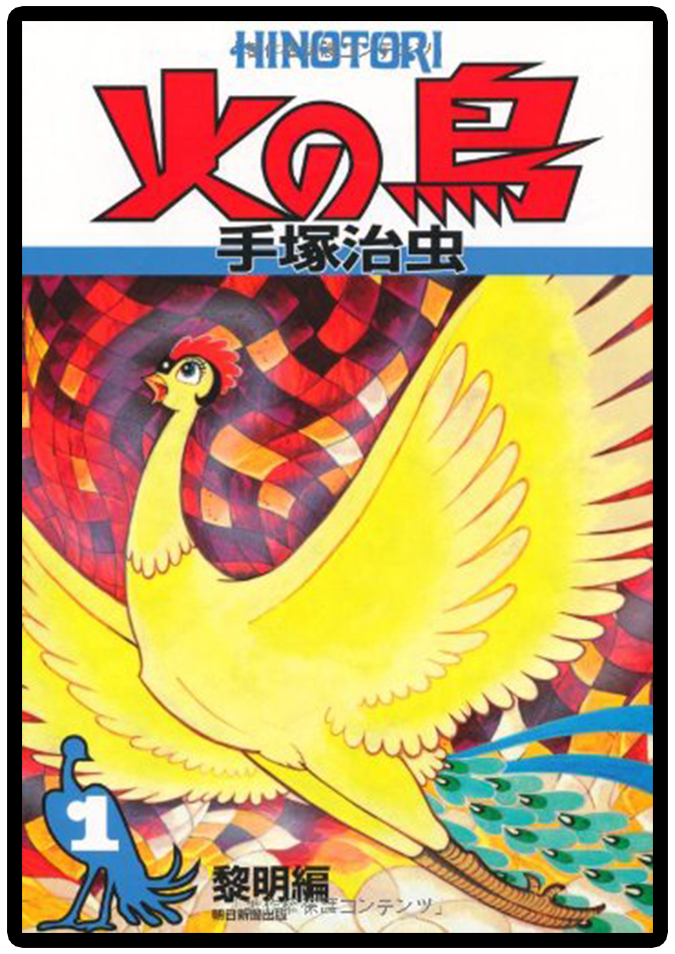
Dr Lava notes: This description of drinking Phoenix blood to gain everlasting life isn’t derived from real-life legends, but rather, from an unfinished manga series called Phoenix. The Phoenix series was created by Osamu Tezuka, who’s often called the Godfather of Manga and considered the Japanese equivalent of Walt Disney. Tezuka began working on the first volume of the Phoenix manga in the 1950’s, and over the next three decades he completed 12 volumes, each telling separate and self-contained stories of different characters hunting the Phoenix so they can live forever by drinking its blood. But in the end, immortality is always unobtainable, or in the rare instances where it is achieved, living forever reveals itself to be a terrible curse. Each volume takes place in the ancient past or distant future, and as the series progresses, it seems to be converging on the present day.
Tezuka considered Phoenix his life’s work, but he died in 1989 before he could finish the series — his last words were “I’m begging you, let me work!”, which he said to a nurse trying to take away his drawing equipment. This Pokedex says the legend of the Phoenix is based on Moltres, but clearly, it’s Moltres who’s based on the Phoenix, an homage to Osamu Tezuka’s unfinished life work. …Or at the very least, its lore is an homage — according to Game Freak, in many cases they come up with a design first then decide the lore later, so it’s possible they created three elemental birds and the designs ultimately inspired the lore, rather than the lore inspiring the designs.

“#146 Arcanine: A legendary Pokémon that appears in Chinese folklore. Sanctified paper chits imprinted with an Arcanine illustration are considered beneficial for keeping evil at bay.”
Dr Lava notes: The book includes this diagram of Kanto’s fastest runners, identifying Arcanine as the fastest of them all (pictured above, translated). Later in-game entries say Arcanine can run 10,000 kilometers in a single day and night — assuming that means 24 hours, that averages out to 417 kilometers an hour.
Arcanine draws inspiration from Chinese Shishi, as well as their Japanese equivalents Shisa and Komainu. Over the past thousand years, Shishi have taken many forms and go by countless names all across Asia, but in simple terms, they’re guardian lions or lion-dogs that originated in Chinese Buddhism. They’re believed to ward off evil, and are usually placed at the entrances of important buildings like temples, imperial palaces, and burial tombs. While Mew is Kanto’s only Mythical Pokemon, most fans consider the Three Birds and Mewtwo as the region’s Legendaries.
But what exactly is a Legendary Pokemon? There’s not actually a proper definition, a situation described most succinctly by the fansite Bulbapedia, which explains that: “No explicit criteria defines what makes a Pokémon a Legendary Pokémon. Instead, the only way to identify a Pokémon as belonging to this group is through statements from official media, such as the games or anime.” This book is as official as it gets, and it classifies Arcanine as a Legendary. Every in-game Pokedex calls Arcanine a “Legendary Pokemon” as well, and in the second episode of the anime, Ash sees an engraving of Arcanine together with the three Legendary Birds. The word “Legendary” is only used in Red, Green, and Blue versions six times, and only one of them suggests Arcanine isn’t a Legendary Pokemon. After defeating him in battle, a Bird Keeper on Route 14 says: “The 3 legendary POKéMON are all birds of prey.” As a Bird Keeper he’s clearly got bird bias, and he’s apparently ignorant to Mewtwo’s existence as well, so if this was a court case, a judge would probably find him an unreliable witness and have his testimony stricken from the record.
This book, as well as another book published a year later, also refer to the Dragonite family as Legendary Pokemon, and describe Dratini as the first Legendary ever discovered. The dragons are usually considered “Pseudo-Legendaries,” but that term was entirely made up by fans. If we set aside fan theories and only take official media into account, an argument can certainly be made that Kanto actually has eight Legendary Pokemon — the three birds, three dragons, Arcanine, and Mewtwo. Or at least, that was Game Freak and Creatures’ original intention back in the mid-90’s, which appears to have changed in the decades since — for example, in later generations the GTS filter lets you exclude players looking for Legendaries, and neither Arcanine or the Dragons are on that list.

“#147 Dratini: Legendary Pokémon live! A Safari Zone visitor just happened to catch a Dratini in the park’s pond. The lucky angler became an overnight sensation with news of the discovery exploding globally. This fortuitous accident convinced many that all legendary Pokémon exist without any doubt. It ignited a massive wave of Pokémon expeditions. Even when young, Dratini reach a length of nearly 2 meters. They grow by repeatedly shedding.”
Dr Lava notes: This story about the first recorded Dratini sighting was lightly expanded upon in another Japanese book published the following year. It came with this illustration and the caption read: “In a recent study, it has been observed how some Pokemon appear in myths and legends. Once, this Pokémon was thought to be a mythical Pokemon only found in legends, but when the story of a Dratini caught while fishing in the Safari zone spread, the number of researchers who believed in its existence increased. There are many rumors of unidentified creatures all over the world, maybe they’re Pokémon.”

“#148 Dragonair: They live in the seas and lakes. They can freely summon rain and snow. Though they have no wings, they are said to fly high in the sky.”

“#149 Dragonite: In spite of their bulky physique, they can orbit the earth in around sixteen hours. They are said to represent the god of destruction.”
Dr Lava notes: Flying around the world in sixteen hours means Dragonite has a top speed of about 2505 kilometers an hour. The book provides this diagram of the world’s fastest flyers, showing Dragonite’s the fastest of them all, and just a little bit faster than a fighter jet (pictured above, translated).

“#150 Mewtwo: There is an urban legend of a mad scientist whose tenacious recombination of Pokémon DNA resulted in a horrifically brutal creature. Could such a frightening Pokémon really exist?”
Closing Comments
And that’s it, that’s the whole Pokédex. Mew doesn’t receive any entry — the only time it’s mentioned is in the later Journal section, where Bill’s giving a lecture and is interrupted by a phone call informing him a mysterious 151st Pokemon’s been discovered. Except for a few useless pages like type match-up charts, pretty much this whole book has now been translated, so check out the links below if you wanna see more of what it has to offer. Or check out this website’s homepage for lots more Pokemon translations.
I wanna give a big thanks to Nob Ogasawara for this translation, DidYouKnowGaming for funding most of it, and HiResPokemon for all the scans. And also thanks to my Patreon supporters who keep the constant flow of translations coming. There are lots more translations only available on Patreon, so click here if you’re interested in supporting my work for $5 a month. Thanks for reading.
Skip to: Part 1 | 2 | 3 | 4 | 5 | 6 | 7 | Journal | Maps | Itoh Art | Interview | More

